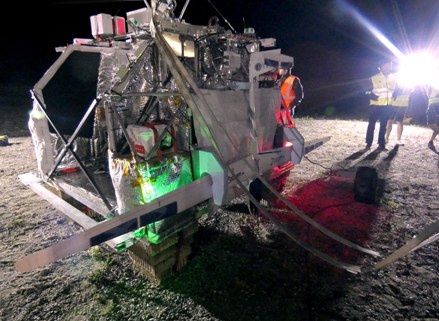Finding the solutions to the mysteries of the high – energy space particles

Night sky of the Earth is glowing. Dim light present especially in the upper part of the atmosphere is however not visible to the naked eye. During the day, oxygen molecules are decomposed by ultraviolet light. These atoms form the O2 molecule again during the night and consequently emit a photon. Such light is called airglow.
Airglow is ten million times weaker than daylight. Despite that it poses a problem to the observation of an attractive physical phenomenon that are Ultra High Energy Cosmic Rays (UHECR) showers of particles. The origin of UHECR particles has been an unsolved question of the astrophysics for the last 60 years. Nowadays, more than 300 researchers from 16 countries collaborate on preparation of the experiment called Extreme Universe Space Observatory (EUSO) which will be examining traces of UHECR showers directly in the space. Collaboration team includes Institute of the Experimental Physics SAS and Technical University of Košice as well. One of the important parts is mapping of the airglow rays, as this light presents the biggest obstacle to observation of the cosmic rays in the atmosphere. Before the launch of the main EUSO experiment, series of preliminary experiments need to take place. Two of them focusing on airglow rays launched recently.
On August 22, 2019 Soyuz MS-14 spacecraft was launched from Baikonur cosmodrome, for the first time in 33 years without crew. The launch served also as a test of Soyuz-2.1a carrier rocket. Cargo delivered to the International Space Station (ISS) included Mini-EUSO experiment as well. It will be installed on the ISS module Zvezda and positioned in the window oriented to Earth. From here it is going to monitor the airglow of the night side atmosphere of the Earth, matter consisting of quarks and other atmospheric phenomenons.
On August 31, 2019 weather balloon of the French space agency CNES was launched in Timmins, Canada. Carrying several scientific experiment in its gondola it started its stratospheric mission Strato Science 2019. On the side of gondola, a glider HiDRON has been attached. With wingspan of 3.4 m it serves for flights in very high altitudes. It has been developed by Canadian startup company Stratodynamics as an advanced alternative to weather balloons.
CNES balloon with HiDRON glider reached 34km altitude. HiDRON detached and began its independent flight mission HiDRON Airglow. This mission was carried out for Institute of Experimental Physics SAS in Košice. Airglow rays were monitored from HiDRON by detector AMON (Airglow MONitor). AMON detector had formerly been detector of the ground network AMON-net, built and developed by IEP SAS. One AMON monitors night sky in Mexico, another in Canary Islands, one is located in Germany and one in Kolonica. Researchers from IEP SAS are currently adapting AMON detectors for use under space conditions. Timmins flight served as a part of testing.
After its separation from gondola, HiDRON speed increased during its free fall to almost 900 km/h and experienced g-force of 12g. After that it began coordinated flight, reasonably slowed down and continued gliding. Launch of the UAS drone from such a height is probably a world record. The flight ended successfully after 4 hours since the detachment from the balloon.
AMON detector carried by HiDRON glider had been working rightly. It had detected intensity of the rays and collected series of telemetric data. It had withstood extreme conditions at the altitude of 34 kilometers where temperature drops to -60 degrees Celsius. Team from IEP SAS expects the detector to tolerate such conditions in a long term. In 2022, series of AMON detectors and EUSO detector will be launched on the NASA stratospheric balloon (EUSO-SPB2 mission). The flight in the 35 km altitude will last 100 days.
Results and data acquired during these missions and from the AMON-net ground network will be used for creation of airglow time map. It will show various airglow characteristics data, depending on the location and time period.
Original author: P. Bobík
Photo: P. Bobík
This text has originally been published on September 3, 2019.
 Contact
Contact Intranet
Intranet SK
SK






